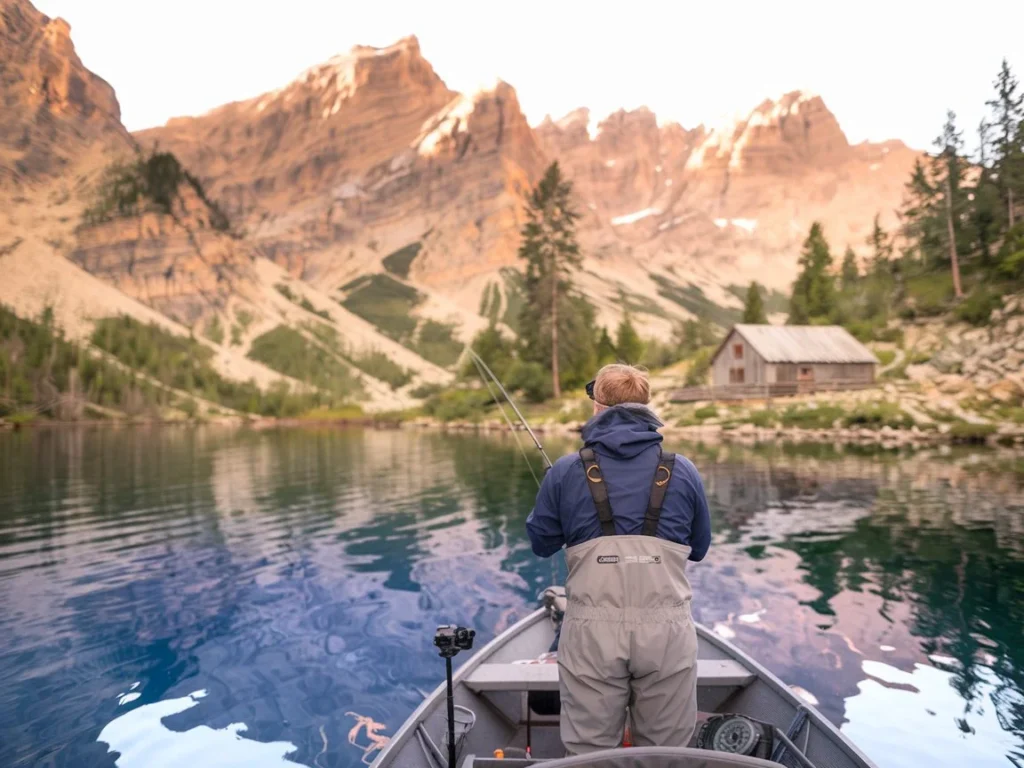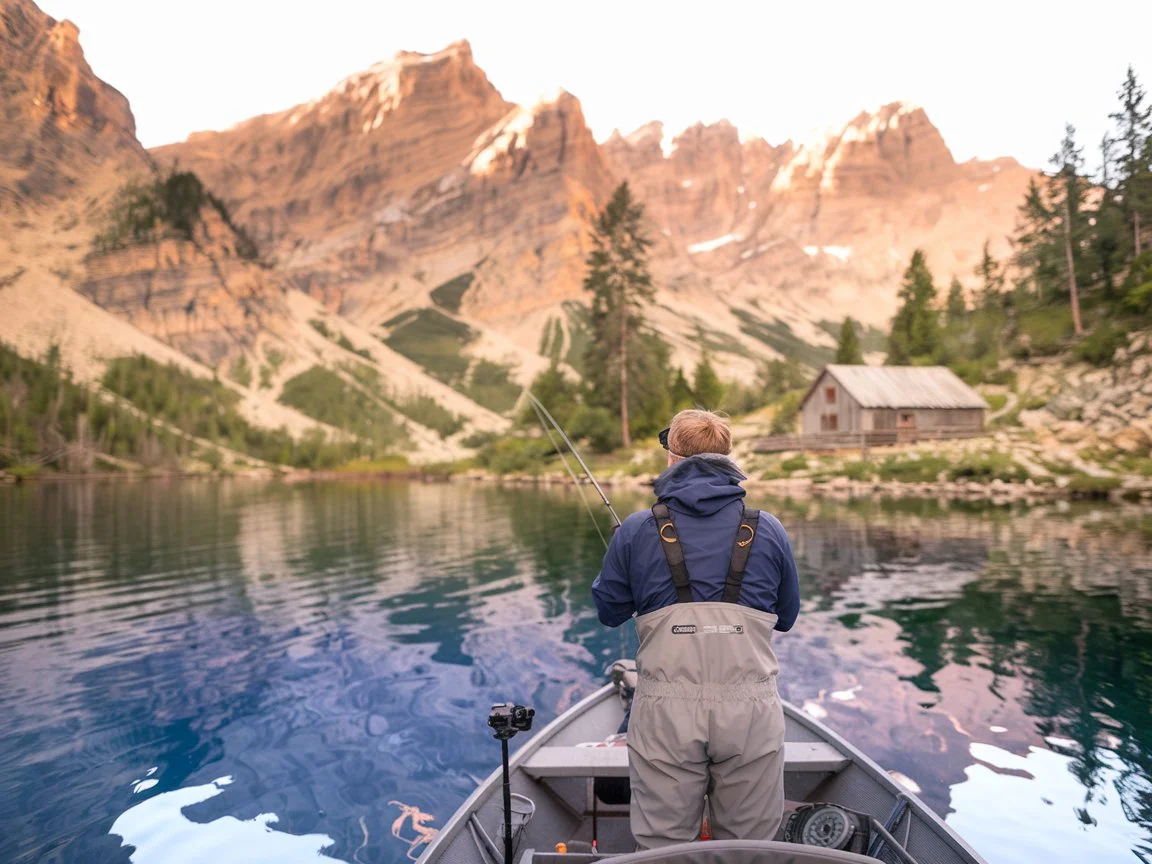
Fishing is a timeless outdoor activity, and there’s no better way to immerse yourself in its tranquility than by casting a line during a mountain cabin retreat. Whether you’re an experienced angler or a beginner, fishing offers a peaceful, meditative experience surrounded by breathtaking landscapes. The calming sound of water, the chirping of birds, and the fresh mountain air make fishing in the wilderness a perfect escape from daily life, discover the “Top Fishing Spots”.
In this guide, we will cover some of the best fishing spots near mountain cabins worldwide, tips for fishing in mountain lakes and streams, the gear you’ll need, and how to ensure an enjoyable and sustainable fishing experience. By the end, you’ll be ready to make fishing the highlight of your mountain retreat.
1. Top Fishing Spots Near Mountain Cabins
Fishing in the mountains offers a diverse range of experiences, from serene alpine lakes to rushing rivers, all surrounded by pristine nature. Here are some of the best fishing destinations near mountain cabins:
- Yellowstone National Park (USA): Known for its geothermal features, Yellowstone is also a haven for anglers. The park boasts clear rivers, lakes, and streams teeming with trout, including cutthroat, rainbow, and brown varieties. Fly fishing enthusiasts can enjoy the peaceful Madison River or the iconic Firehole River.
- Canadian Rockies (Canada): The Canadian Rockies offer numerous secluded mountain lakes perfect for fishing. These crystal-clear lakes, including the famous Lake Louise, are home to rainbow trout, lake trout, and brook trout. Remote locations such as Bow Lake and Moraine Lake provide excellent opportunities to fish surrounded by spectacular mountain vistas.
- Swiss Alps (Switzerland): The Swiss Alps have a variety of alpine lakes offering incredible fishing opportunities. Areas like the Lac de Taney and Lake Geneva are well-known for their abundance of trout and perch. These lakes are surrounded by towering peaks, creating an idyllic setting for a fishing getaway.
- Tatra Mountains (Poland/Slovakia): The Tatra Mountains offer hidden streams and lakes rich with fish diversity, including brown trout and grayling. The beautiful mountain scenery, combined with calm waters, makes it a perfect destination for those looking to fish in a peaceful, remote environment.
Whether you prefer fly fishing or baitcasting, these destinations provide a wealth of opportunities for anglers to relax and enjoy nature.
2. Best Fishing Techniques for Mountain Lakes and Streams
Fishing in mountain lakes and streams presents a unique challenge, with varying conditions and the need for specific techniques. Here are the most effective methods to use when fishing in these serene yet rugged environments:
- Fly Fishing: This technique is ideal for mountain rivers and lakes, where the water is often clear and the fish are selective. Fly fishing allows anglers to cast lightweight flies that mimic insects, making it a great choice for trout. For those fishing in the swift, cold waters of mountain streams, fly fishing offers both a challenge and reward. Rivers like the Madison River in Yellowstone or the streams in the Swiss Alps are perfect for fly fishing, with abundant trout ready to bite.
- Trout Fishing: Trout are the primary catch in many mountain lakes and streams, and various methods can be used to reel them in. Whether you’re casting from the shore or using a boat, it’s essential to choose the right bait and lures. Worms, minnows, and artificial flies work well for native mountain trout. For best results, aim for the cooler, deeper parts of the lake or stream where trout tend to hide.
- Casting and Spinning: For anglers of all skill levels, casting and spinning provide simple yet effective methods for mountain fishing. Using spinners, jigs, or soft plastics can attract fish like bass and perch. For beginners or families with children, this technique can be a fun way to enjoy the experience without the intricacies of fly fishing. A basic spinning reel setup and a good cast can land fish like rainbow trout in the tranquil mountain lakes.
These techniques ensure that no matter your fishing preference or skill level, the mountain lakes and streams offer ample opportunities to make the most of your retreat.
3. Essential Gear for Mountain Fishing Trips
When heading out for a fishing adventure in mountain lakes or streams, having the right gear is essential for both comfort and success. Here’s a breakdown of the must-have items for your mountain fishing trip:
- Fishing Rods, Reels, and Tackle: The type of fishing rod you choose depends on the technique you’ll be using. For fly fishing, a lightweight, flexible rod is ideal, while a sturdier spinning rod works best for casting and trolling. A quality reel is crucial for smooth operation, especially when handling larger fish like trout or bass. Ensure your tackle box is stocked with the necessary lures, hooks, and baits tailored to the specific fish species you’re targeting.
- Clothing and Accessories: Mountain weather can be unpredictable, so dressing in layers is key. Wear moisture-wicking base layers to keep sweat off your skin, followed by a warm mid-layer and waterproof outer layers to protect against rain. High-quality fishing boots are also a must for wading in streams or lakes, ensuring both comfort and protection against sharp rocks. A wide-brimmed hat, sunglasses, and sunscreen will protect you from the sun’s glare, particularly when fishing in high-altitude areas.
- Must-Have Tools: Some fishing tools are indispensable for a successful trip. A fishing net is essential for safely landing your catch, while waders help keep you dry when wading into cold mountain waters. Bring a cooler to store your catch, and if you plan on keeping the fish, make sure to pack ice packs to preserve freshness. A fishing knife is useful for cleaning fish, and a multi-tool can come in handy for various tasks while outdoors.
By ensuring you have the right gear, you’ll be better prepared for the challenges of mountain fishing and can focus on enjoying the experience in the serene surroundings.
4. Local Fishing Regulations and Conservation Efforts
Before casting your line, it’s crucial to understand the local fishing regulations and conservation efforts in the mountain areas you’re visiting. These rules help preserve the natural beauty of the area, protect wildlife, and ensure that fishing remains sustainable for future generations.
- Fishing Seasons, Limits, and Permits: Many mountain regions have specific fishing seasons to protect fish populations during their breeding periods. Be sure to check the dates for the fishing season in the area you plan to visit. Some regions also impose daily or possession limits on the number of fish you can catch, especially for species like trout, which are often targeted in mountain streams. A fishing permit may be required, and it’s essential to obtain the appropriate license before you start fishing.
- Ethical Fishing Practices: To minimize the impact on the environment, practice catch-and-release techniques when possible. This allows the fish to thrive and continue to breed. Additionally, use barbless hooks to reduce injury to fish. It’s also important to respect the waterways by avoiding littering and following Leave No Trace principles.
- Conservation Programs: Many regions have local conservation programs aimed at preserving fish habitats and improving water quality. Participate in these initiatives when possible, whether by donating to organizations or volunteering for local efforts. By adhering to regulations and supporting conservation, you help protect the ecosystems that make mountain fishing such a rewarding experience.
5. How to Prepare for a Successful Fishing Trip
Planning is key to having a memorable and successful fishing trip in the mountains. By preparing in advance, you can ensure a smooth and enjoyable experience, whether you’re a seasoned angler or a beginner.
- Best Times for Fishing: The time of day you choose to fish can significantly affect your success. Early mornings, just as the sun rises, and late evenings are often the best times to catch fish in mountain lakes and streams. During these cooler hours, fish are more active, feeding on insects and small aquatic creatures. Midday fishing can be less productive due to higher water temperatures and fish retreating to deeper, cooler areas.
- Packing Essentials: Be sure to bring the right supplies. Bait, lures, or flies suited to the local fish species are essential, as are extra tackle, rods, and reels. Sunscreen, a hat, and sunglasses will protect you from the sun’s rays. A high-quality cooler is essential for keeping your catch fresh, and a first-aid kit is always a good idea when fishing in remote areas.
- Creating a Relaxing Experience: Mountain fishing isn’t just about catching fish; it’s also about soaking in the tranquil surroundings. Pack a comfortable chair for sitting by the water, snacks for an afternoon break, and a camera to capture the stunning landscapes. Take your time and embrace the serenity of the moment—after all, fishing in such a pristine environment is a treat in itself.
6. Fishing for Families and Beginners
Fishing can be a fantastic family activity and an excellent way for beginners to connect with nature. Whether you’re introducing children to the joy of fishing or looking for a peaceful outing, the mountains offer ideal settings for a relaxed experience.
- Family-Friendly Fishing Locations: Many mountain lakes and streams have easy access, making them perfect for families. Look for spots where the fish are abundant, but the surroundings are calm and safe for children. Places like the Canadian Rockies offer shallow waters where kids can easily wade and fish under supervision.
- Beginner-Friendly Techniques: For those new to fishing, start with simple techniques like bobber fishing or using a basic spinning reel. Trout are often more forgiving and easier to catch for first-timers. Use live bait like worms or small minnows to attract fish in the shallows, which increases your chances of success.
- Making it Fun: Make fishing a low-pressure activity by encouraging a relaxed atmosphere. Pack a picnic and enjoy the experience of being outdoors, regardless of how many fish you catch. This will create lasting memories, even if the fish aren’t biting.
Conclusion
In conclusion, fishing in mountain lakes and streams offers an unmatched opportunity to experience nature in its most peaceful form. Whether you’re casting your line into the pristine waters of Yellowstone or exploring the remote lakes of the Canadian Rockies, the serenity and beauty of mountain fishing make it an unforgettable part of your cabin retreat.
By choosing the Top Fishing Spots, using the best techniques, and packing the right gear, you can ensure a successful and enjoyable fishing trip. Always remember to follow local regulations and conservation efforts to protect these natural resources for future generations.
Finally, whether you are a seasoned angler, a family looking for a fun bonding experience, or a beginner seeking a peaceful retreat, fishing in the mountains is a rewarding adventure that enhances the overall cabin getaway experience. So, grab your fishing gear, embrace the tranquility, and let the mountain streams lead you to relaxation and joy.
If you’re looking to complement your fishing trip with some hiking, check out our guide on the best hiking trails near mountain cabins to enhance your cabin getaway experience.
To ensure you’re well-prepared for your fishing adventure, visit The Fishing Authority for expert advice on gear and techniques.

